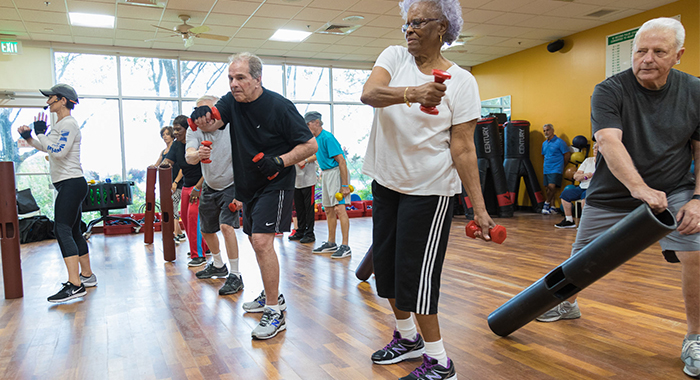Exercise is an important part of healthy living for everyone. For people with Parkinson’s disease (PD), exercise is more than healthy — it is a vital component to maintaining balance, mobility, and activities of daily living (i.e. bathing, toileting, cooking, and dressing). Exercise and physical activity can improve many PD symptoms. These benefits are supported by research.
The Parkinson’s Outcomes Project shows that people with PD who start exercising earlier and a minimum of 2.5 hours a week, experience a slowed decline in quality of life compared to those who start later. Establishing early exercise habits is essential to overall disease management.
What Type of Exercise Should I Do?
To help manage the symptoms of PD, be sure your exercise program includes a few key ingredients:
- Aerobic activity
- Strength training
- Balance, agility, and multitasking
- Flexibility
The Parkinson’s Foundation, in collaboration with the American College of Sports Medicine, created new Parkinson’s disease (PD) exercise recommendations to ensure that people with Parkinson’s are receiving safe and effective exercise programs and instruction.
The new exercise guidelines include recommended frequency, intensity, time, type, volume, and progression of exercises that are safe and effective for people with Parkinson’s across four domains: aerobic activity, strength training, balance, agility, multitasking, and stretching. Each recommendation is paired with specific types of activity and special safety considerations for people with PD.
Parkinson’s Exercise Recommendations (available in multiple languages)
These elements are included in many types of exercise. Biking, running, Tai chi, yoga, Pilates, dance, weight training, non-contact boxing, qi gong and more — all have positive effects on PD symptoms.
There is no “exercise prescription” that is right for every person with PD. The type of exercise you do depends on your symptoms and challenges. For sedentary people, just getting up and moving is beneficial. More active people can build up to regular, vigorous activity. Many approaches work well to help maintain and improve mobility, flexibility and balance to ease non-motor PD symptoms such as depression or constipation.
Researchers in the study did not distinguish between what type of exercise participants did and determined that all types of exercise are beneficial. The most important thing is to do the exercise regularly. We suggest finding an exercise you enjoy and stick with it.
Challenges to Exercising
- People in the early stages of PD tend to be just as strong and physically fit as healthy individuals of the same age.
- Disease progression can lead to the following physical change:
- Loss of joint flexibility, which can affect balance.
- Decreased muscle strength or deconditioning which can affect walking and the ability to stand up from sitting.
- Decline in cardiovascular conditioning, which affects endurance.
Tips for Getting Started
- First, be safe. Before starting an exercise program, we recommend you to see a physical therapist specializing in Parkinson’s for full functional evaluation and recommendations..
- Use a pedometer (step-counter) and figure out how many steps you take on average each day, then build up from there. Many smartphones or smartwatches have a built-in pedometer feature or an application that can be downloaded.
- Exercise indoors and outdoors. Change your routine to stay interested and motivated.
- Again, most importantly pick an exercise you enjoy.
source: www.parkinson.org

